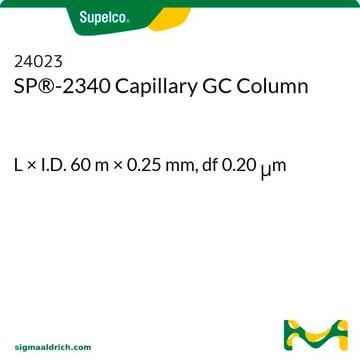25319
SP®-2380 GC-Kapillarsäule
L × I.D. 30 m × 0.53 mm, df 0.20 μm
About This Item
Empfohlene Produkte
Materialien
fused silica
Agentur
meets requirements for USP G48
Parameter
≤25-275 °C temperature (isothermal or programmed)
Beta-Wert
663
df
0.20 μm
Methode(n)
gas chromatography (GC): suitable
L × ID
30 m × 0.53 mm
Aktive Matrixgruppe
Stabilized; poly(90% biscyanopropyl/10% cyanopropylphenyl siloxane) phase
Anwendung(en)
agriculture
chemicals and industrial polymers
clinical
food and beverages
Säulenart
capillary highly polar
Suchen Sie nach ähnlichen Produkten? Aufrufen Leitfaden zum Produktvergleich
Allgemeine Beschreibung
USP-Code: Diese Säule erfüllt die Anforderungen von USP G48.
Phase:
- Stabilisiert
- Poly (90 % Biscyanopropyl/10 % Cyanopropylphenyl-Siloxan)
- Umgebungstemperatur bis 275 °C (isothermal oder programmiert)
Anwendung
- SP®-2380 Capillary Column may be used for determination of fatty acid composition in crude oil in capillary gas chromatography, used along with normal and reverse-phase high-performance liquid chromatography (HPLC) in order to study the content and composition of tocopherols, sterols, and phospholipids in soybean oils derived from genetically-modified soybeans.
- It was found suitable to be used for the identification of fatty acid methyl esters from mammalian samples by fast gas chromatography.
- It was suitable for determining the hydrogenation level and the level of isomerisation development during the hydrogenation process of edible oils by capillary gas chromatography.
- It was also suitable to be used in gas chromatography equipped with flame ionization detector (FID) for analysing the cytotoxicity of fatty acids from seed oils containing conjugated linolenic acids (CLN) on mouse tumor and human monocytic leukemia cells.
Sonstige Hinweise
Rechtliche Hinweise
Choose from one of the most recent versions:
Besitzen Sie dieses Produkt bereits?
In der Dokumentenbibliothek finden Sie die Dokumentation zu den Produkten, die Sie kürzlich erworben haben.
Unser Team von Wissenschaftlern verfügt über Erfahrung in allen Forschungsbereichen einschließlich Life Science, Materialwissenschaften, chemischer Synthese, Chromatographie, Analytik und vielen mehr..
Setzen Sie sich mit dem technischen Dienst in Verbindung.


